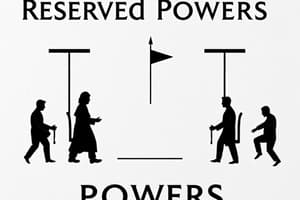Podcast
Questions and Answers
An officer for a corporation takes out numerous loans from the company's qualified retirement plan. Which of these rules is the plan in violation of?
An officer for a corporation takes out numerous loans from the company's qualified retirement plan. Which of these rules is the plan in violation of?
- Exclusive benefit rule (correct)
- Vesting rule
- Key employee rule
- Top heavy rule
Tom has a qualified retirement plan with his employer that is currently considered to be 80% 'vested'. How can this be interpreted?
Tom has a qualified retirement plan with his employer that is currently considered to be 80% 'vested'. How can this be interpreted?
- If Tom's employment is terminated, 80% of the funds would be forfeited
- 20% of the funds are subject to taxes
- If Tom's employment is terminated, 20% of the funds would be forfeited (correct)
- 80% of the funds are invested in a separate account
An employee requested that the balance of her 401(k) account be sent directly to her in one lump sum. Upon receipt of the distribution, she immediately has the funds rolled over into an IRA. What is the tax consequence of the distribution sent to this employee?
An employee requested that the balance of her 401(k) account be sent directly to her in one lump sum. Upon receipt of the distribution, she immediately has the funds rolled over into an IRA. What is the tax consequence of the distribution sent to this employee?
- Distribution is subject to federal income tax withholding (correct)
- Distribution is subject to ordinary income tax
- Distribution is subject to capital gains tax
- Distribution is subject to a tax penalty
Tim is retired and has recently separated from his wife. He receives benefits from a qualified retirement plan through his former employer. The plan's trustee has decided to split these benefit payments between Tim and his estranged wife. This decision is likely in violation of which IRS rule?
Tim is retired and has recently separated from his wife. He receives benefits from a qualified retirement plan through his former employer. The plan's trustee has decided to split these benefit payments between Tim and his estranged wife. This decision is likely in violation of which IRS rule?
A retirement plan that sets aside part of the company's net income for distributions to qualified employees is called a:
A retirement plan that sets aside part of the company's net income for distributions to qualified employees is called a:
What is the maximum number of employees (earning at least $5,000) that an employer can have in order to start a SIMPLE retirement plan?
What is the maximum number of employees (earning at least $5,000) that an employer can have in order to start a SIMPLE retirement plan?
How are Roth IRA distributions normally taxed?
How are Roth IRA distributions normally taxed?
What does a 401(k) plan generally provide its participants?
What does a 401(k) plan generally provide its participants?
In a qualified retirement plan, the yearly contributions to an employee's account:
In a qualified retirement plan, the yearly contributions to an employee's account:
An individual participant personally received eligible rollover funds from a profit-sharing plan. What are the income tax withholding requirements for this transaction?
An individual participant personally received eligible rollover funds from a profit-sharing plan. What are the income tax withholding requirements for this transaction?
Rick recently died and left behind an individual IRA account in his name. His widow was forwarded the balance of the IRA. The widow qualifies for the:
Rick recently died and left behind an individual IRA account in his name. His widow was forwarded the balance of the IRA. The widow qualifies for the:
An individual working part-time has an annual income of $2,500. If this individual has an IRA, what is the maximum deductible IRA contribution allowable?
An individual working part-time has an annual income of $2,500. If this individual has an IRA, what is the maximum deductible IRA contribution allowable?
According to ERISA regulations, a Summary Plan Description must be provided to a new plan member within ___ days of the member's eligibility date.
According to ERISA regulations, a Summary Plan Description must be provided to a new plan member within ___ days of the member's eligibility date.
A trustee-to-trustee transfer of rollover funds in a qualified plan allows a participant to avoid:
A trustee-to-trustee transfer of rollover funds in a qualified plan allows a participant to avoid:
How long does an individual have to 'rollover' funds from an IRA or qualified plan?
How long does an individual have to 'rollover' funds from an IRA or qualified plan?
Which of these is a true statement regarding survivor benefits under a qualified retirement plan?
Which of these is a true statement regarding survivor benefits under a qualified retirement plan?
In an individual retirement account (IRA), rollover contributions are:
In an individual retirement account (IRA), rollover contributions are:
Which tax would an IRA participant be subjected to on distributions received prior to age 59 1/2?
Which tax would an IRA participant be subjected to on distributions received prior to age 59 1/2?
Under the IRS 'minimum coverage' rules, a qualified retirement plan must:
Under the IRS 'minimum coverage' rules, a qualified retirement plan must:
Who is normally considered to be the owner of a 403(b) tax-sheltered annuity?
Who is normally considered to be the owner of a 403(b) tax-sheltered annuity?
Flashcards are hidden until you start studying
Study Notes
Retirement Plans Overview
- The exclusive benefit rule prohibits officers from taking loans from a qualified retirement plan for personal use.
- Vesting reflects ownership of retirement funds; with 80% vesting, 20% is forfeited if employment ends.
- Funds distributed from a 401(k) rolled into an IRA are subject to federal income tax withholding.
Key Retirement Plan Rules
- Alienation of benefits prevents division of benefits without proper conditions in place, such as during marital separations.
- A profit-sharing plan allocates part of a company's income for employee distributions, incentivizing performance.
Retirement Account Specifications
- A maximum of 100 employees earning at least $5,000 can participate in a SIMPLE retirement plan.
- Roth IRA distributions are tax-free, differing from traditional IRAs which may involve penalties and taxes.
- Participants in 401(k) plans typically make salary-deferral contributions, allowing pre-tax savings.
Contribution and Tax Regulations
- Employee yearly contributions in qualified plans are subject to maximum levels set by the IRS.
- An individual receiving rollover funds from a profit-sharing plan incurs a 20% withholding for income tax.
- Surviving spouses are entitled to a marital deduction from inherited IRAs.
Contributions and Limitations
- An individual with a part-time income of $2,500 can fully deduct this amount as an IRA contribution.
- Summary Plan Descriptions must be provided within 90 days of eligibility under ERISA regulations.
Rollover and Transfer Guidelines
- A trustee-to-trustee transfer allows for avoidance of mandatory tax withholding, ensuring full amount is rolled over without penalty.
- Individuals have 60 days to complete a rollover from an IRA or qualified plan.
Survivor Benefits and Early Withdrawals
- Survivor benefits require consent from a married spouse to be waived, ensuring protection for dependents.
- Individuals under age 59½ face a 10% penalty and ordinary income tax on withdrawals from IRAs.
Coverage Requirements
- Qualified retirement plans must benefit a broad cross-section of employees, ensuring inclusiveness among workers.
- The owner of a 403(b) tax-sheltered annuity is generally the employee, providing personal control over their retirement funds.
Studying That Suits You
Use AI to generate personalized quizzes and flashcards to suit your learning preferences.




